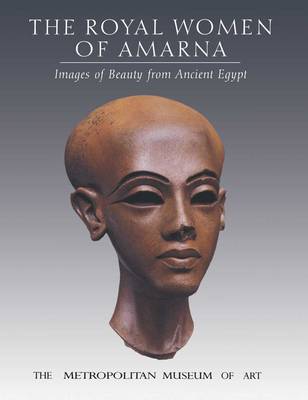During a brief seventeen-year reign (ca. 1353-1336 B.C.) the pharaoh Amenhotep IV/Akhenaten, founder of the world's first known monotheistic religion, devoted his life and the resources of his kingdom to the worship of the Aten (a deity symbolized by the sun disk) and thus profoundly affected history and the history of art. The move to a new capital, Akhetaten/Amarna, brought essential changes in the depictions of royal women. It was in their female imagery, above all, that the artists of Amarna departed from the traditional iconic representations to emphasize the individual, the natural, in a way unprecedented in Egyptian art.
A picture of exceptional intimacy emerges from the sculptures and reliefs of the Amarna Period. Akhenaten, his wife Nefertiti, and their six daughters are seen in emotional interdependence even as they participate in cult rituals. The female principle is emphasized in astonishing images: the aging Queen Mother Tiye, the mysterious Kiya, and Nefertiti, whose painted limestone bust in Berlin is the best-known work from ancient Egypt-perhaps from all antiquity.
The workshop of the sculptor Thutmose-one of the few artists of the period whose name is known to us-revealed a treasure trove when it was excavated in 1912. An entire creative process is traced through an examination of the work of Thutmose and his assistants, who lived in a highly structured environment. All was left behind when Amarna was abandoned after the death of Akhenaten and the return to religious orthodoxy.
Dorothea Arnold, then the Lila Acheson Wallace curator in charge of the Department of Egyptian Art at the Metropolitan Museum, has provided a landmark art-historical exploration of a period when the confluence of religion, art, and politics resulted in a unique epoch.
James P. Allen, then associate curator, Department of Egyptian Art, has elucidated this revolutionary era in the history of religion, a time when the governing principle of life was a "sole god, with no other except him," light itself.
In her brief biographical summaries, the Egyptologist L. Green of Scarborough College, the University of Toronto, places the royal women of Amarna in genealogical context. [This title was originally published in 1999.]
- ISBN10 0300200277
- ISBN13 9780300200270
- Publish Date 10 September 2013 (first published 1 October 1996)
- Publish Status Cancelled
- Publish Country US
- Imprint Metropolitan Museum of Art
- Format Paperback (US Trade)
- Pages 192
- Language English
